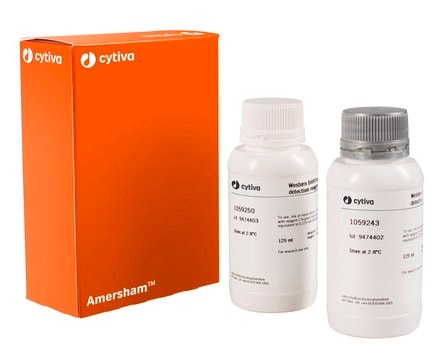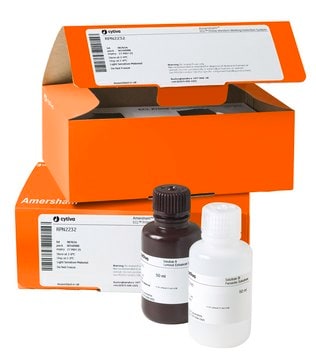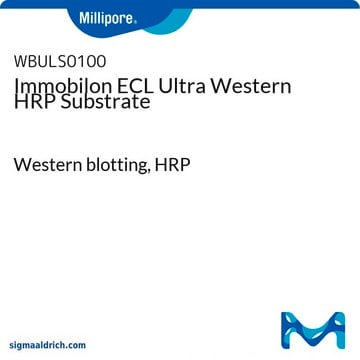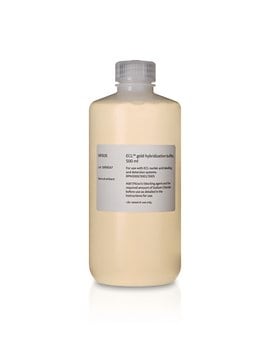GERPN3004
ECL™ Detection Reagents
Cytiva RPN3004, pack of 1 ea
Iniciar sesiónpara Ver la Fijación de precios por contrato y de la organización
About This Item
UNSPSC Code:
41105300
NACRES:
NA.31
Productos recomendados
packaging
pack of 1 ea
manufacturer/tradename
Cytiva RPN3004
storage temp.
2-8°C
Categorías relacionadas
General description
The world’s first commercially available chemiluminescent detection reagent for Western blotting. Amersham ECL detection reagent uses enhanced luminol-based detection suitable for all routine confirmatory Western blotting experiments.
Based on the enhanced chemiluminescent reaction of luminol with horseradish peroxidase, ECL substrate can be used to detect probes which have been labelled either directly or indirectly with horseradish peroxidase. Rapid light output enables results to be achieved in 10 to 15 minutes. It is the substrate of choice for target amounts above 500 fg.
High sensitivity and fast results:
Based on the enhanced chemiluminescent reaction of luminol with horseradish peroxidase, ECL substrate can be used to detect probes which have been labelled either directly or indirectly with horseradish peroxidase. Rapid light output enables results to be achieved in 10 to 15 minutes. It is the substrate of choice for target amounts above 500 fg.
High sensitivity and fast results:
- Detects up to 10 to 12 ng of protein, which is ~10× more than colorimetric methods
- Optimized to use with Amersham Protran nitrocellulose (NC) membranes
- Delivers results in just a few minutes, then image using a CCD imager like the Amersham ImageQuant 800 or Amersham Hyperfilm ECL
Storage and Stability
Please be aware this product may be shipped 90 days before the expiration date. For more information on the batch specific expiration date, please contact technical service.
Analysis Note
To view the Certificate of Analysis for this product, please visit www.cytiva.com.
Legal Information
ECL is a trademark of Cytiva
related product
Referencia del producto
Descripción
Precios
Storage Class
12 - Non Combustible Liquids
Certificados de análisis (COA)
Busque Certificados de análisis (COA) introduciendo el número de lote del producto. Los números de lote se encuentran en la etiqueta del producto después de las palabras «Lot» o «Batch»
¿Ya tiene este producto?
Encuentre la documentación para los productos que ha comprado recientemente en la Biblioteca de documentos.
Los clientes también vieron
Senia Rosales et al.
BMC microbiology, 10, 208-208 (2010-08-04)
Tuberculosis persists as a public health problem in Honduras. A better knowledge of the molecular characteristics of Mycobacterium tuberculosis strains will contribute to understand the transmission dynamics of the disease within the country. The aim of this study was to
G Y Akita et al.
Journal of veterinary diagnostic investigation : official publication of the American Association of Veterinary Laboratory Diagnosticians, Inc, 5(2), 154-158 (1993-04-01)
A previously described bluetongue virus (BTV) serogroup polymerase chain reaction (PCR) assay was applied to clinical samples. The sensitivity of the BTV serogroup PCR was increased by the use of non-radioactive chemiluminescent hybridization. Unfractionated whole blood samples from rams experimentally
C Couturier et al.
Arteriosclerosis, thrombosis, and vascular biology, 20(12), 2559-2565 (2000-12-16)
Type II secreted phospholipase A(2) (sPLA(2)) releases precursors of important inflammatory lipid mediators from phospholipids. Some observations have indicated that the sPLA(2), which has been implicated in chronic inflammatory conditions such as arthritis, contributes to atherosclerosis in the arterial wall.
H M Peng et al.
Molecular pharmacology, 54(4), 740-747 (1998-10-10)
The regulation of cytochrome P450 (CYP) 2E1, the ethanol-inducible isoform, is particularly complex. The level is affected by a variety of other foreign compounds, by insulin (as studied in several laboratories), and by triiodothyronine (T3), which has not been previously
K Aogi et al.
Clinical cancer research : an official journal of the American Association for Cancer Research, 5(10), 2790-2797 (1999-10-28)
The analysis of the tissue expression patterns of both the telomerase enzyme and the adhesion molecule CD44 has highlighted these molecules as potential tumor markers. In this study, the expression of these markers was analyzed in frozen tissue samples of
Artículos
Background and protocols describing the various methods used by molecular biologists to detect samples of protein or nucleic acids bound to membranes.
Nuestro equipo de científicos tiene experiencia en todas las áreas de investigación: Ciencias de la vida, Ciencia de los materiales, Síntesis química, Cromatografía, Analítica y muchas otras.
Póngase en contacto con el Servicio técnico










